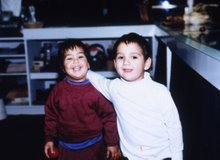Having just finished reading
Botánica Los Angeles: Latino Popular Religious Art in the City of Angels, edited by Patrick A. Polk, I have some things to say.
Firstly, it is a beautiful book full of bright colors, detailed pictures of altars, store fronts, and personalized public spaces which reflect the provocative aesthetic that I call home. I loved flipping through the pages, recognizing the images from my childhood, and seeing how similarly and how differently these icons can be expressed in another city.
The writing of this book gave me some interesting thoughts. When Polk approaches the botánica for the first time, he takes the reader, the uninitiated reader, into the shop and at first glance proclaims it mysterious. The mysterious botánica. While I understand an initial reaction to the cluttered unfamiliar aesthetic, I would take the conversation beyond the fieldworker and point out that a large part of the appeal of such spaces to the community they serve is their familiarity. The very images that expressed mystery to Polk, or uncertainty to Romberg (in
Witchcraft and Welfare, 2003) are the images that mean home, safety, and blessing to me and perhaps to the thousands of people who use botánicas. Has this publication frozen the image of mystery in the minds of all those whose only visit to a botánica will be within the pages of this book, the only book published about botánicas? I hope not. Perhaps this is why I have chosen to frame my exhibit within the stories of my family, so to communicate that an experience with spirits and saints and blood and bone, with
limpios and
baños can be a place where a family grows.
Secondly, I wonder about some small contradictions within the book. In Polk's second essay he takes the task of defining the most common traditions found within the botánica and practiced by its clients. His definition of espiritismo is based upon the following of Alan Kardec's texts. While its true that Kardec's work brought orthodox espiritismo to the island, and catalyzed a "craze" that has now turned into a vernacular practice, I can attest that not all espiritistas follow Kardec's words. In fact, not all espiritistas have heard of Kardec, let alone keep his books on their altars. This section of the essay makes no distinction between how people say they practice and how they actually practice. In a later essay by Claudia Hernández and Michael Owen Jones, a proprietor of a botánica explains, "Before being a santero, I am an espiritista. An espiritista is born an espiritista" (48). This quote, to me, shows that this practitioner is not identifying his practice with Kardec's books, but with an ability to interact with spirits. I am mindful not to impose any official doctrine on people who are labeling themselves based on ability, not based on their association with books from Europe. Can't this practice be defined by the people who practice it, instead of by the European who also believed in it? I am not denying Kardec's influence on the practice of Espiritismo, but I wonder how we can ever write about popular culture and really get it right. Everyone has their own practice.
In the same essay Polk shows four major categories of practice within a botánica. It seems to me that none of these are necessarily separated in practice. I grew up watching my grandmother practice all four of these mentioned practices (Palo, Espiritismo, Folk Catholicism, Curanderismo). I was taught these, with the exception of Palo, as one large practice, and I was taught to include all four of them as elements in my altar. As a folklorist, I find it imperative that information published about foreign topics be representative of how practitioners (in this case) see what they do. But, I understand the need, in the context of a museum catalog, to answer the straight forward question...what is this? For now I will suggest to teh public, go to my exhibit, then visit a botánica, ask the proprietor, "What do you do?" and then understanding their answer as something distinctly different from what the last one told you and what the next one will tell you.














 Selina Morales (me) with a lizard on my head! Typical.
Selina Morales (me) with a lizard on my head! Typical. Lela, who has always revered the power of snakes, was delighted at the opportunity to introduce her young granddaughter to a serpent. When I showed Maxine (about 1 year old in the picture) the photo at her high school graduation party everyone was in stiches about the expression on Lela as well as Max's face.
Lela, who has always revered the power of snakes, was delighted at the opportunity to introduce her young granddaughter to a serpent. When I showed Maxine (about 1 year old in the picture) the photo at her high school graduation party everyone was in stiches about the expression on Lela as well as Max's face.
 Omar Morales Armstrong and Selina Morales. We showed this picture to Omar's baby girl Erica who was amazed at her father's bravery. Her mouth dropped open even wider as we showed her another photo where he was holding a white RAT!
Omar Morales Armstrong and Selina Morales. We showed this picture to Omar's baby girl Erica who was amazed at her father's bravery. Her mouth dropped open even wider as we showed her another photo where he was holding a white RAT!


 Community Members.
Community Members.










